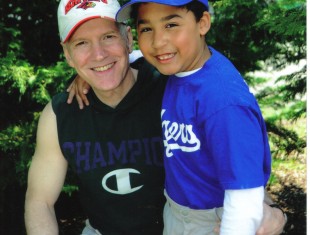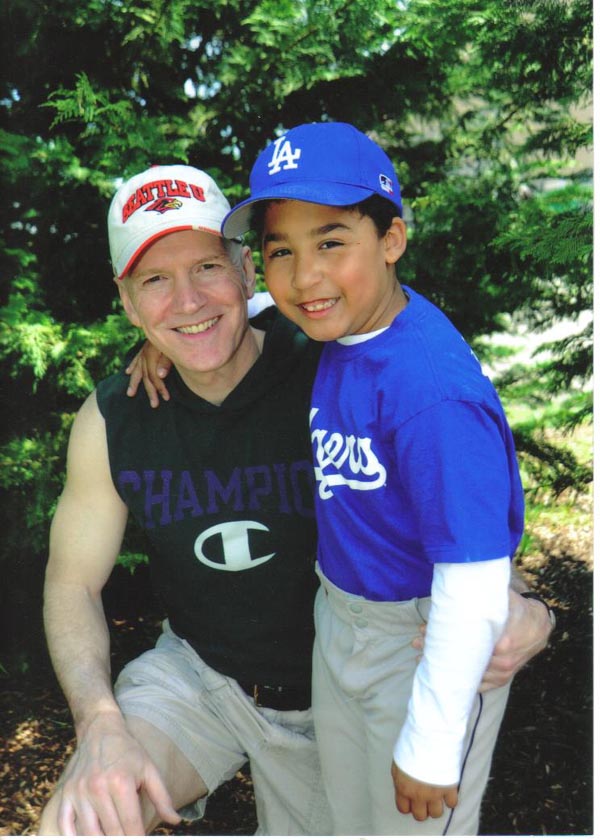CLAY MOYLE AND SON CALEB
By Clay Moyle
This is fifth column I’ve written in this series concerning my post-concussion journey that began in early September of 2015. I hope they may prove useful to anyone who experiences anything like this in the future
When I revisited the first column I wrote a couple of weeks into this ordeal, I have to shake my head about how naive I was at the time. I had no clue how difficult the coming months were going to be.
To provide some background for anyone who may not have read the previous columns in this series, I fell off a ladder on September 7 and was knocked unconscious for approximately seven to nine minutes.
Long story short, I suffered a grade three concussion, three fractured ribs, something called a fourth cranial nerve palsy, and have no memory of the first three-four hours after I was revived.
The ribs injury resolved itself in a few weeks. The cranial nerve palsy resulted in various degrees of blurred and double vision over the next six months. I was thrilled when I could finally look at a basketball rim that was no longer blurred a couple months ago.
At the three-month mark, an ophthalmologist had expressed the opinion that I might end up needing to wear prism glasses for the rest of my life if the condition didn’t improve. I’m thrilled that wasn’t the case.
I ultimately came to realize that the concussion I suffered was in effect a mild-traumatic brain injury (TBI).
As I explained in the fourth column I wrote in this series, the brain is comprised of blood vessels which can tear and bleed soon after suffering a head injury. The bleeding usually stops and those blood vessels heal. An MRI revealed that I suffered several scattered areas of minor bleeding and I was told there was some evidence of neuron damage.
The bruises, torn nerves and blood vessels can result in a variety of unpleasant symptoms after one suffers a TBI. Among those I specifically experienced myself included extreme fatigue, reduced concentration, memory problems, anxiety, depression, and sensitivity to light, along with a constant dazed-foggy feeling. Most of these symptoms lasted in different combinations for months at a time.
I shared the fact that most people who suffer a mild TBI eventually realize a full recovery in time, but it can take many months and sometimes up to a year or more for that to occur. Individuals over 40 years old are more likely to take six to 12 months to heal.
There was a period of time as long as three to four months after my accident where I wasn’t able to work longer than four hours before I was completely exhausted. When I got home I needed to take a nap. I forced myself to get out and walk for 30-minutes per day and ate as healthy as possible, but I learned I needed to spend a tremendous amount of time simply resting.
For many months, seemingly everything I did seemed harder for me to accomplish and I got tired very easily.
Just shy of six months into this, I stumbled across an article concerning a study that was performed at the University of Buffalo that I found extremely helpful. The researchers took a group of individuals who were suffering post concussive symptoms for many months and another normal group of individuals of similar age and capabilities. They asked each individual to perform a series of mathematical problems while they were wired up in a manner that allowed them to monitor their levels of brain activity.
They discovered that both groups completed the tasks in approximately the same amount of time and with the same degree of accuracy. But, while the normal subjects only had to use a few specific regions of their brains, the brains of the post-concussive patients lit up like Christmas trees as a result of having to use multiple areas.
They determined that post-concussive patients required far more mental resources to perform cognitively. No wonder they tire so easily. Perhaps the most frustrating part of this is that the party suffering in that manner most likely looks and behaves so closely to normal that they appear fine to almost everyone around them. But, the individuals themselves know they are in fact seriously messed up and far from normal.
Through the use of imaging studies, the university researchers found changes in the brains of post-concussive patients that they concluded “appear to arrive from metabolic and physiologic changes rather than psychological changes as had been suggested in the past. All patients showed an altered cerebral blood flow, compared to the brains of the normal subjects.”
Ultimately, they concluded that blood flow to the cerebrum becomes irregular after a concussion.
Furthermore, they said those imaging studies “showed less activation in key areas of the brain, including the posterior cingulate, a relay station for multiple cognitive functions that is often underactive in studies of dementia patients.”
More recently, I came across another excellent article titled ‘The Gift of Neuroplasticity’ by Dr. David Perlmutter that furthered my understanding concerning this issue and the healing process. Neuroplasticity is described as the brains ability to change and reorganize itself and its function.
A book written by Dr. Joe Dispenza titled ‘Evolve Your Brain’ explains that the individual working unit of the brain is the single neuron, but that even simple tasks require the recruitment of vast numbers of interconnected neurons functioning as a unit or network.
There are literally millions of neurons in our brains that team up to form communities of nerve cells that act in unison as a group in relation to a particular concept, idea, memory, skill or habit. Whole patterns of neurons throughout the brain become connected through the process of learning and are used to carry out everyday functions.
Now what happens when an individual suffers a brain injury is that in addition to torn nerves and blood vessels, there are neurons and connections between neurons that are damaged or destroyed. When one considers that those neurons and connections may be part of various networks that have been used to help us perform even the simplest of tasks, it’s easy to understand how life can suddenly become so much harder and tiring for someone trying to effectively function after suffering a brain injury.
The good news is that the gift of neuroplasticity means that we can not only realize the growth of new neurons throughout our lifetime, but our brains can essentially rewire themselves over time as we perform specific activities on a repetitive basis and learn new things.
Furthermore, when one studies this topic they learn that there are specific actions that can be taken to facilitate the growth of new neurons and that rewiring process. For example, diet and exercise is a key part of the process.
Most of us have long realized the positive benefits of both diet and exercise, but this miserable experience and my resulting personal research has definitely furthered my knowledge in that regard.
For example, in the previously mentioned University of Buffalo study, the researchers took that group of post concussive individuals and split them into two halves. One half was instructed to simply rest and do a number of stretching exercises over the next 12 weeks.
But, they put the other half on a daily graded cardio program over that same period. Patients were told to exercise to the point where their symptoms such as dizziness and headaches increased, and they were then instructed to exercise at 80 percent of the heart rate where their symptoms worsened for 20-minutes a day on equipment that doesn’t involve a lot of bouncing or movement of the head going forward.
Ultimately, they found that the 12-week graded cardio program restored cerebral blood flow for those post concussive individuals and normal brain function when performing the same mathematical problems they’d been asked to accomplish previously.
The director of the university’s Concussion Management Clinic concluded that at some point it’s okay for people with concussions to begin exercising again, as long as they’ve seen a doctor and had testing done under medical supervision. “As this catches on, you might see people in health clubs or fitness facilities who are actually doing this program and trying to recovery from concussion symptoms,” he added.
Well, I can tell you I was thrilled when I came across this because I was sick and tired of just going for daily 30-minute walks for almost six months. So, approximately 10 weeks ago I began doing my own daily cardio program while also lifting weights twice a week using approximately 75 percent of my pre-accident weights.
Of course, I didn’t enlist any medical supervision, but I did monitor my heart rate while doing 25-30 minutes of cardio. Initially I discovered that if I let my heart rate get above 135 or so that I would start feeling a little loopy (dizzy?), but I’d go ahead and push through that and find that I wouldn’t get over the feeling for another 30 minutes afterward.
After a few more days like that, I finally decided I really didn’t make myself miserable so I backed off the intensity level on the elliptical machine I was using and found that as long as I kept my heart rate below 135 it wasn’t all that unpleasant and I’d generally feel good much faster afterward.
That said, I will say that over the past 10 weeks there have been plenty of times where working out hasn’t been a very pleasant experience. But, I come from the no-pain no-gain school of thought and I’ve probably been pushing it too much. Still, I’ve realized significant improvement and am feeling better and better, so I am staying the course as I gradually continue to ramp it up.
Of late, I’ve incorporated 10-15 minutes of jump roping because I’ve found that my vision wasn’t as good as it was before when I’m bouncing or moving around. I just don’t seem to be able to visually track things as well as I had previously.
I’ve realized significant improvement as I continue to work on things like jump roping, playing catch, balancing exercises, and playing some one-on-one basketball with youngsters.
That brings me to another point. One of the other most unpleasant post-concussive experiences has been exposure to crowded, busy, noisy environments. I’ve learned that’s not untypical. I found that walking around a somewhat noisy store like Safeway, Costco or a shopping mall where there was a lot of product and lots of other people moving about, in addition to moving around myself, was often very overwhelming and I couldn’t wait to get back out to the car where I could simply sit and close my eyes for a few minutes.
I decided to do some research concerning that problem as well and that led to my learning about something called sensory gating. According to Wikipedia, sensory gating describes neurological processes of automatically filtering out redundant and unnecessary stimuli in the brain from all possible environmental stimuli. Essentially, it prevents an overload of irrelevant information in the higher cortical centers of the brain.
There is some evidence that mild head injury and the subsequent post concussive symptoms that individuals experience may be due to the inadequate integration of the input of various sensory experiences, caused by deficient processing capacity.
So, lately I’ve been trying to learn more about how to best facilitate the recovery of sensory integration and gating capabilities.
Additionally, I came across something called Chronis Subjective Dizziness that refers to this problem with crowded, busy, noisy environments that seems to indicate vestibular physical therapy may help, so I’m checking into that as well.
For the longest time, I’d told doctors that I hadn’t experienced any dizziness whatsoever because I was only thinking of dizziness in the manner one feels after getting off one of those rides at an amusement park that spins you around too much
But, I’ve come to learn there are different forms of dizziness and quite possibly what I described as a loopy, dazed, foggy condition for many months may actually have been a form of dizziness.
I’m trying to learn as much as I possibly can to help myself. I continue to realize ongoing improvements from my efforts and am doing my best to follow the path the Lord lays before me.
Time, rest and patience are key, but I’ve learned there are specific actions one can take to aid their own recovery in terms of both the rate and degree of that recovery. I’m determined to do everything I possibly can to realize a complete recovery as quickly as I possibly can.



